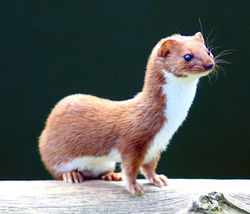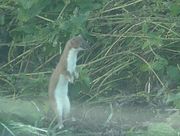Least Weasel
| Least Weasel | |
|---|---|
 |
|
| An alert Least Weasel | |
| Conservation status | |
| Scientific classification | |
| Kingdom: | Animalia |
| Phylum: | Chordata |
| Class: | Mammalia |
| Order: | Carnivora |
| Family: | Mustelidae |
| Subfamily: | Mustelinae |
| Genus: | Mustela |
| Species: | M. nivalis |
| Binomial name | |
| Mustela nivalis Linnaeus, 1766 |
|
The Least Weasel, also known as the dwarf, pygmy, or mouse weasel (Mustela nivalis) is the smallest of all species of the Carnivora order [2], making it the smallest true carnivore [3]. Least Weasels can be found throughout the world, including the Palearctic region (excluding Ireland, the Arabian Peninsula, and the Arctic Isles), Japan, New Zealand and in North America (throughout Alaska, Canada, and Northern United States)[4][5].
Contents |
Habitat
The least weasel is commonly found in meadows, marshes, farmlands, prairies, semi-deserts and grassy fields, yet tends to avoid woodlands, sandy deserts and open spaces [6]. It often remains unnoticed, although the population may be abundant [7].
Description
Appearance
.jpg)
The least weasel has a long, slender body with short, fine underfur and longer guard hairs. It possesses a flat, narrow head, with black eyes and round ears. It has short limbs with its feet having five fingers with sharp claws[8]. In the summer, the least weasel's upperparts are a rich chocolate brown and the underparts are white. In the winter (in northern areas where snow is common) the pelage is completely white and remains brown in southern regions [9]. Males are larger than females:
Total length: 180-250 mm (males); 165-180 mm (females)
Length of tail: 25-40 mm (males); 22-30 mm (females)
Weight: 40-55 g (males); 30-50 g (females)
Least weasel scat is 1/8-1/4 in. (0.3-0.6 cm) diameter, and 3/4-2 in. (1.9-5.1 cm) Long. They form latrines near nests. [10]
Mustela nivalis can be distinguished from Mustela erminea by its small body size and short tail that lacks a black terminal brush, and from Mustela frenata by its total length less than 300 mm and tail length less than 100 mm [11].
Habits
Mustela nivalis is active year-round. It is neither nocturnal nor diurnal. It spends its time, day and night, hunting, feeding, and sleeping [12]. When the least weasel hunts, it watches its prey's movements before attacking [13]. It will then dart erratically from side to side and rush its victim. Once encountered, the least weasel wraps itself around its victim and kills with a bite to the base of the skull [14]. Both male and female least weasels have body diameters no larger than their prey, which allows them to to follow their prey into burrows, tunnels, and matted grass. Least weasel trails have explored holes, nooks and crannies in rock walls, under buildings, in root systems, trees, and under the snow. They also tunnel in deep snow [15].
The least weasel will cover an area of two acres while searching for prey, and commonly will have more than one den. When it can, a weasel will kill more than it can eat when prey is available, and stores it in its den for future meals [16].
Diet
Small rodents make up the majority of the least weasel's diet. On average, this small carnivore must consume half of its body weight every day to survive. This is about two deer mice or one meadow vole each day [17]. When rodents are not readily available, the least weasel will eat birds' eggs, nestlings, insects, and lizards. In the extreme northern populations Mustela nivalis will eat carcasses of brown lemmings [18].
Reproduction
Male least weasels reach sexual maturity at eight months, while females reach maturity at four months [19]. Males are sexually active throughout the year but most breeding occurs in spring and late summer [20] . Female least weasels will have multiple litters throughout the year, which is different from the long-tailed weasel and ermine. The gestation period is 35 days. Females care for and nurse their young until they become independent [21].
Litters may range from 1-6 and the young are born wrinkled, pink, naked, blind and deaf [22]. At 11 days, the young are covered with a fine white body hair, and by 18 days they have brown hair on their backs with white bellies. At this point, the young are eating solid food [23]. The least weasel is able to kill prey at 40 days into their lifespan [24].
Subspecies
- (Mustela nivalis allegheniensis), southern Great Lakes states from Wisconsin to Illinois east through Pennsylvania, and in Appalachian Mountains south to North Carolina.
- (Mustela nivalis campestris), South Dakota, Nebraska, Iowa, northern Nebraska, and Arkansas.
- (Mustela nivalis eskimo), Alaska and Yukon Territories.
- (Mustela nivalis rixosa), Mackenzie Delta across Canada and south into northern Montana, North Dakota, and Minnesota.
- North Weasel (Mustela nivalis nivalis), North-Scandinavia, Russia, North-America
- South Weasel (Mustela nivalis vulgaris), South Europe and Middle Asia
- Dwarf Weasel (Mustela nivalis minuta), North-Scandinavia
Legacy

Least Weasels are highly solitary, and even mating does not occur without a fight. Females can breed several times in a year when food is plentiful. Perhaps because of their small size, Least Weasels have an even greater reputation for ferocity than other weasels, and there are many references to them in the popular cultures of different countries.
Traditional Inuit lore held the Least Weasel in great respect because of its pugnacious nature, and the capture of one was regarded as an omen of good luck. In classical and medieval European mythology, it is sometimes said that the only thing which can kill a basilisk is a weasel (by which is meant Mustela nivalis), though it would be killed in the conflict as well. The earliest record of this claim is in Pliny's Naturalis Historia, book 8, par. 33.[25] It was repeated by Isidore of Seville in his Etymologiae, and subsequently by many medieval bestiarists.
References
- ↑ Tikhonov, A., Cavallini, P., Maran, T., Kranz, A., Herrero, J., Giannatos, G., Stubbe, M., Conroy, J., Kryštufek, B., Abramov, A., Wozencraft, C., Reid, F. & McDonald, R. (2008). Mustela nivalis. In: IUCN 2008. IUCN Red List of Threatened Species. Downloaded on 21 March 2009. Database entry includes a brief justification of why this species is of least concern
- ↑ Wilson, Don E.; Ruff, Sue, eds (1999). The Smithsonian Book of North American Mammals. Washington and London: Smithsonian Institution Press. pp. 173 - 174. ISBN 1-56098-845-2.
- ↑ BBC, science and nature (2008). ""Weasel,least weasel" (on-line)". http://www.bbc.co.uk/nature/wildfacts/factfiles/202.shtml. Retrieved 2009-12-08.
- ↑ Newell, T. (1999). ""Mustela nivalis" (On-line)". Animal Diversity Web.. http://animaldiversity.ummz.umich.edu/site/accounts/information/Mustela_nivalis.html. Retrieved 2009-10-19.
- ↑ Anonymous (2005). ""Mustela nivalis" (On-line)". Global Invasive Species Database. http://www.issg.org/database/species/ecology.asp?fr=1&si=443. Retrieved 2010-03-08.
- ↑ Newell, T. (1999). ""Mustela nivalis" (On-line)". Animal Diversity Web.. http://animaldiversity.ummz.umich.edu/site/accounts/information/Mustela_nivalis.html. Retrieved 2009-10-19.
- ↑ Wilson, Don E.; Ruff, Sue, eds (1999). The Smithsonian Book of North American Mammals. Washington and London: Smithsonian Institution Press. pp. 173 - 174. ISBN 1-56098-845-2.
- ↑ Newell, T. (1999). ""Mustela nivalis" (On-line)". Animal Diversity Web.. http://animaldiversity.ummz.umich.edu/site/accounts/information/Mustela_nivalis.html. Retrieved 2009-10-19.
- ↑ Wilson, Don E.; Ruff, Sue, eds (1999). The Smithsonian Book of North American Mammals. Washington and London: Smithsonian Institution Press. pp. 173 - 174. ISBN 1-56098-845-2.
- ↑ Elbroch, Mark (2003). Mammal Tracks & Sign: A Guide to North American Species. PA: Stackpole Books. p. 479. ISBN 0-8177-2626-6.
- ↑ Wilson, Don E.; Ruff, Sue, eds (1999). The Smithsonian Book of North American Mammals. Washington and London: Smithsonian Institution Press. pp. 173 - 174. ISBN 1-56098-845-2.
- ↑ Wilson, Don E.; Ruff, Sue, eds (1999). The Smithsonian Book of North American Mammals. Washington and London: Smithsonian Institution Press. pp. 173 - 174. ISBN 1-56098-845-2.
- ↑ Newell, T. (1999). ""Mustela nivalis" (On-line)". Animal Diversity Web.. http://animaldiversity.ummz.umich.edu/site/accounts/information/Mustela_nivalis.html. Retrieved 2009-10-19.
- ↑ Wilson, Don E.; Ruff, Sue, eds (1999). The Smithsonian Book of North American Mammals. Washington and London: Smithsonian Institution Press. pp. 173 - 174. ISBN 1-56098-845-2.
- ↑ Elbroch, Mark (2003). Mammal Tracks & Sign: A Guide to North American Species. PA: Stackpole Books. p. 479. ISBN 0-8177-2626-6.
- ↑ "Least Weasel". eNature.com. 2007. http://www.enature.com/fieldguides/detail.asp?recnum=MA0453. Retrieved 2009-10-19.
- ↑ Wilson, Don E.; Ruff, Sue, eds (1999). The Smithsonian Book of North American Mammals. Washington and London: Smithsonian Institution Press. pp. 173 - 174. ISBN 1-56098-845-2.
- ↑ Newell, T. (1999). ""Mustela nivalis" (On-line)". Animal Diversity Web.. http://animaldiversity.ummz.umich.edu/site/accounts/information/Mustela_nivalis.html. Retrieved 2009-10-19.
- ↑ Wilson, Don E.; Ruff, Sue, eds (1999). The Smithsonian Book of North American Mammals. Washington and London: Smithsonian Institution Press. pp. 173 - 174. ISBN 1-56098-845-2.
- ↑ Newell, T. (1999). ""Mustela nivalis" (On-line)". Animal Diversity Web.. http://animaldiversity.ummz.umich.edu/site/accounts/information/Mustela_nivalis.html. Retrieved 2009-10-19.
- ↑ Newell, T. (1999). ""Mustela nivalis" (On-line)". Animal Diversity Web.. http://animaldiversity.ummz.umich.edu/site/accounts/information/Mustela_nivalis.html. Retrieved 2009-10-19.
- ↑ Newell, T. (1999). ""Mustela nivalis" (On-line)". Animal Diversity Web.. http://animaldiversity.ummz.umich.edu/site/accounts/information/Mustela_nivalis.html. Retrieved 2009-10-19.
- ↑ Wilson, Don E.; Ruff, Sue, eds (1999). The Smithsonian Book of North American Mammals. Washington and London: Smithsonian Institution Press. pp. 173 - 174. ISBN 1-56098-845-2.
- ↑ Wilson, Don E.; Ruff, Sue, eds (1999). The Smithsonian Book of North American Mammals. Washington and London: Smithsonian Institution Press. pp. 173 - 174. ISBN 1-56098-845-2.
- ↑ Pliny the Elder. "Natural Historia, book 8, par. 33.". Perseus at Tufts University. http://www.perseus.tufts.edu/cgi-bin/ptext?lookup=Plin.+Nat.+8.33. Retrieved 2009-06-03.
- Khalaf-von Jaffa, Norman Ali Bassam Ali Taher (2006). The Common Weasel (Mustela nivalis, Linnaeus 1766) in Palestine and the East Mediterranean Region.Gazelle: The Palestinian Biological Bulletin. Number 57, September 2006. pp. 1-7.
|
|||||||||||||||||||||||||||||||||||||||||||||||||||||||||||||||||||||||||||||||||||||||||||||||||||||||||||||||||||||||||||||||||||||||||||||||||||||||||||||||||||||||||||||||||||||||||||||||||||||||||||||||||||||||||||||||||||||||||||||||||||||||||||||||||||||||||||||||||||||||||||||||||||||||||||||||||||||||||||||||||||||||||||||||||||||||||||||||||||||||||||||||||||||||||||||||||||||||||||||||||||||||||||||||||||||||||||||||||||||||||||||||||||||||||||||||||||||||||||||||||||||||||||